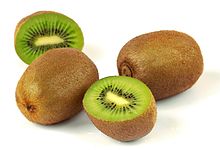Kiwifruit
From Wikipedia, the free encyclopedia
This article is about the fruit. For the bird, see Kiwi. For the TV series, see Kiwifruit (TV series).
The kiwifruit, often shortened to kiwi in many parts of the world, is the edible berry of a woody vine in the genus Actinidia.[1]
The most common cultivar group of kiwifruit ('Hayward')[2] is oval, about the size of a large hen's egg (5–8 centimetres (2.0–3.1 in) in length and 4.5–5.5 centimetres (1.8–2.2 in) in diameter). It has a fibrous, dull greenish-brown skin and bright green or golden flesh with rows of tiny, black, edible seeds. The fruit has a soft texture and a sweet but unique flavor, and today is a commercial crop in several countries, such as Italy, New Zealand, Chile,Greece and France.[3]
Human consumption
| ||||||||||||||||||||||||||||||||||||||||||||||||||||
| ||||||||||||||||||||||||||||||||||||||||||||||||||||
Raw kiwifruit is rich in the protein-dissolving enzyme actinidain(in the same family of thiol proteases as papain), which is commercially useful as a meat tenderizer. Actinidain also makes raw kiwifruit unsuitable for use in desserts containing milk or any other dairy products which are not going to be served within hours, because the enzyme soon begins to digest milk proteins. This applies to gelatin-based desserts as well, as the actinidain will dissolve the collagen proteins in gelatin very quickly, either liquifying the dessert, or preventing it from solidifying.
To overcome this effect, the United States Department of Agriculture suggests cooking the fruit for a few minutes before adding it to gelatin.[30] Sliced kiwifruit has long been regularly used as a garnish atop whipped cream on the common New Zealand and Australian dessert, thepavlova. It can also be used in a variety of other savoury and sweet dishes.
[edit]Allergies
The actinidain found in kiwifruit can be an allergen for some individuals.[31][32][33] Specifically, people allergic to latex, bananas, papayas, or pineapples are likely to also be allergic to kiwifruit. The fruit also contains calcium oxalate crystals in the form of raphides. Reactions to these chemicals include sweating, tingling and sore mouth or throat; swelling of the lips, tongue and face; rash; vomiting and abdominal pain, heartburn; and, in the most severe cases, breathing difficulties, wheezing and collapse. The most common symptoms are unpleasant itching and soreness of the mouth, with the most common severe symptom being wheezing. Severe symptoms are most likely to occur in young children.
[edit]Nutrition
Kiwifruit is a rich source of vitamin C (1.5 times the United States DRI per 100 grams) and vitamin K, and a good source of dietary fiber and vitamin E.[30][34] The fruit and skin contain flavonoids, actinidain, and adhered pollen, which may produce irritation in the mouth and throat of some allergic individuals.[32]
Kiwifruit seed oil contains on average 62% alpha-linolenic acid, an omega-3 fatty acid.[35] Usually a medium size kiwifruit provides about 46 calories,[36] 0.3 g fat, 1 g protein, 11 g carbohydrates, and 2.6 g dietary fiber found partly in the edible skin.[37] Kiwifruit is often reported to have mild laxative effects, due to its significant levels of dietary fiber.[38]
Kiwifruit components, possibly involving vitamin E and omega-3 fatty acids from its numerous edible seeds, have potential properties of a natural blood thinner. A study performed at the University of Oslo in Norway reported that consuming two to three kiwifruit daily for 28 days significantly reduced platelet aggregation and blood triglyceride levels (similar to popular mainstream aspirin therapy), potentially reducing the risk of blood clots.[41]


No comments:
Post a Comment